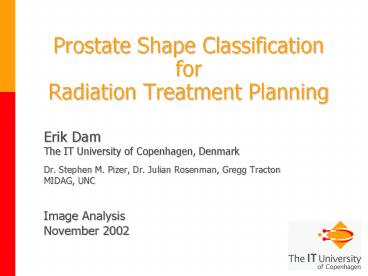Prostate Shape Classification for Radiation Treatment Planning - PowerPoint PPT Presentation
1 / 14
Title:
Prostate Shape Classification for Radiation Treatment Planning
Description:
Diagnosis (enlargement, PSA count, ...) Segmentation. Planning. Radiation treatment ... Leave one out. Image Analysis, November 2002. 11. The Data Collection ... – PowerPoint PPT presentation
Number of Views:47
Avg rating:3.0/5.0
Title: Prostate Shape Classification for Radiation Treatment Planning
1
Prostate Shape Classification for Radiation
Treatment Planning
- Erik Dam
- The IT University of Copenhagen, Denmark
- Dr. Stephen M. Pizer, Dr. Julian Rosenman, Gregg
Tracton - MIDAG, UNC
- Image Analysis
- November 2002
2
Prostate Cancer Radiation Treatment
- Phases
- Diagnosis (enlargement, PSA count, )
- Segmentation
- Planning
- Radiation treatment
3
Radiation Treatment Planning
- High dosage in cancer tissue leads to lower
relapse rate - Surrounding organs are fragile
- Optimal beam configuration depends on (a.o.)
- Size (field size, possibly hormones)
- Location (proximity to other organs)
- Shape(wrap around rectum)
- Boundaries(larger margin when fuzzy)
www.yoursurgery.com
4
The Goal
- Classification
- Classify organs conformations in groups that
require similar beam configurations
5
The Classification Process
- Classes
- Sizesmall/medium/large
- Shapesaddlebag/not
- Boundarydiffuse/distinct
- Classes
- Sizesmall/medium/large
- Shapesaddlebag/not
- Boundarydiffuse/distinct
6
Two Data Sets
- Coronal
Sagittal
Axial
The entire data collection has 46 cases (11
saddlebags and 35 not)
7
M-Rep Shape Model
- Medial Representation
- Think Skeleton
- Grid of medial Atoms
- Each Atom define two sail vectors that give two
boundary points, boundary is then interpolated - Model is optimized to fit image
8
M-Rep Features
- Global
- Volume
- Surface area
- Local at each Atom
- Radius
- Row/Column bend
9
Classification
- Done in three simple steps
- Reduction of feature space dimensionality by
Fisher linear discrimination - Gaussian modeling of classes
- Maximal a posteriori probability used to
determine class
10
Evaluation
- Leave one out
11
The Data Collection ...
- Originally 52 data sets
- But 6 were discarded 3 without prostate, 2
without prostate segmentation, 1 due to too poor
image quality - Of the remaining 46 sets there are
- 11 saddlebag-shaped
- 35 normal (not saddlebag-shaped)
12
The Simpler Alternative
- For reasons of simplicity, we will skip the M-rep
model in the remaining part of this presentation.
- Instead the concepts are illustrated with a
simpler model with very simple features.
13
Naïve Engineering Alternative ...
- Do as follows
- Find the three points in each slice
- Sort slices by sumof differences L/R
- Pick the five best
- These differences squared gives a feature vector
with 10 numbers
14
Results
- Comments
- Of the 11 saddlebag cases 8 were correctly
classified - Of the 35 normal cases, 2 were classified
uncorrectly - With real data, much better results can not be
expected!































